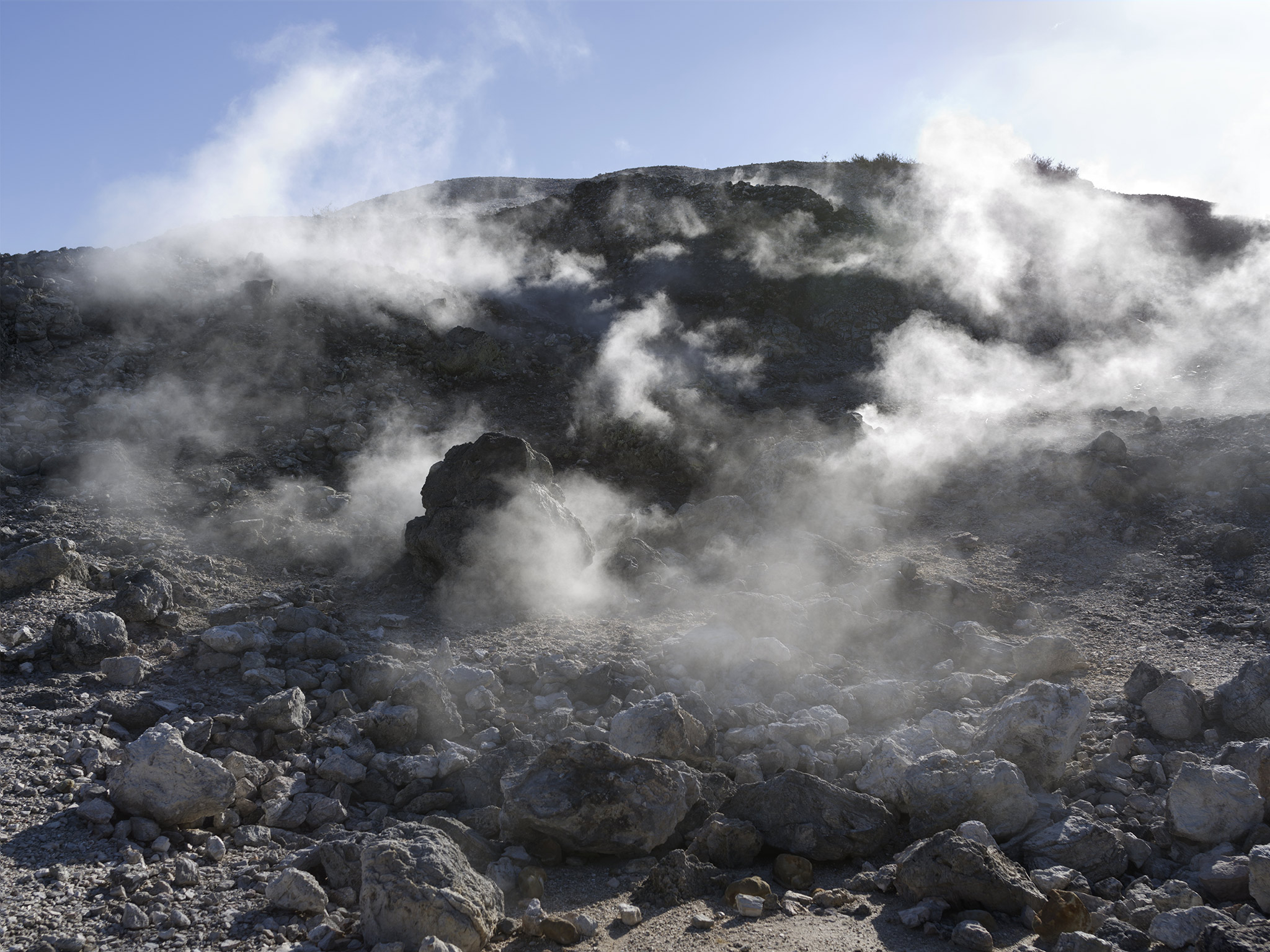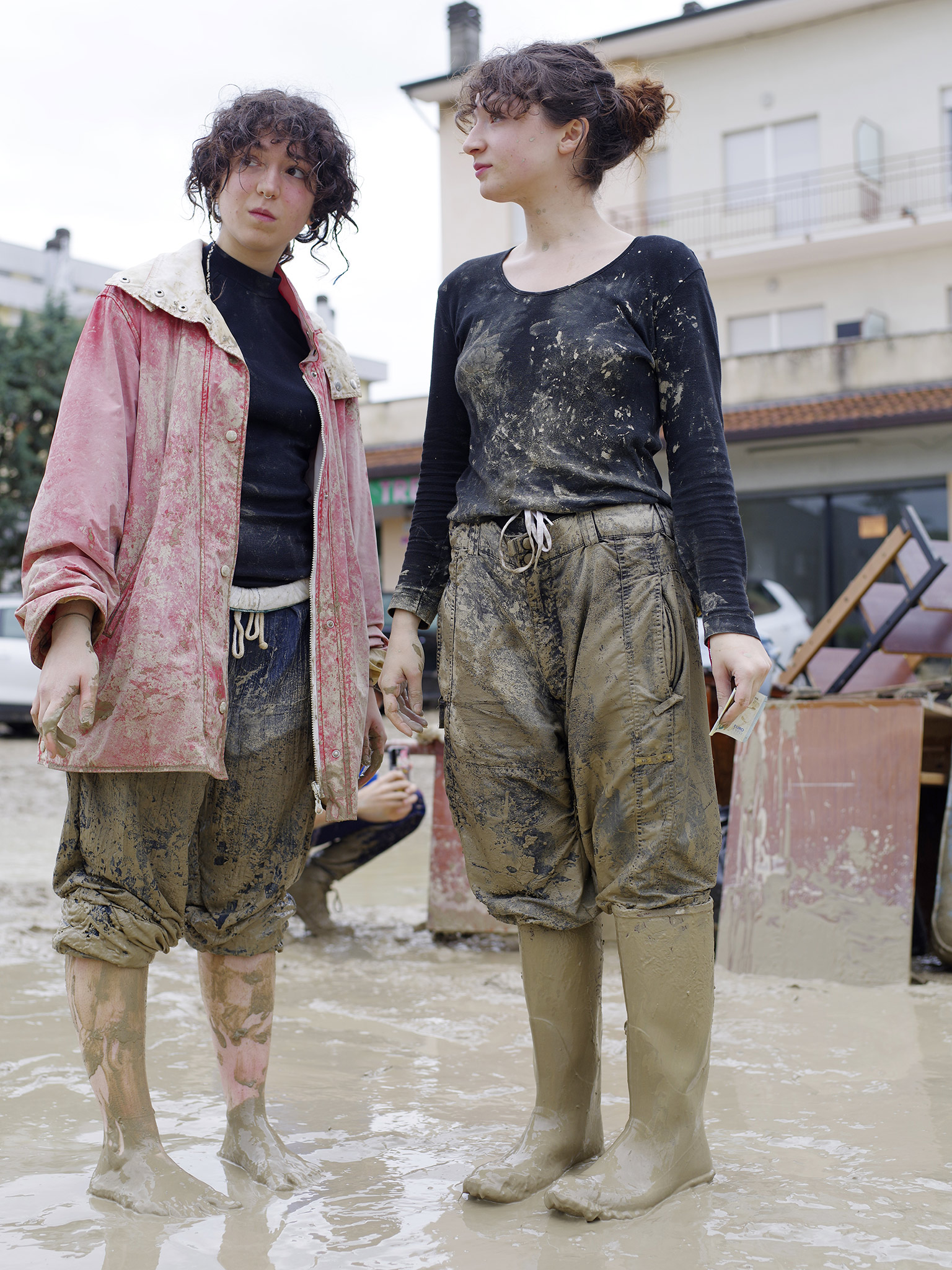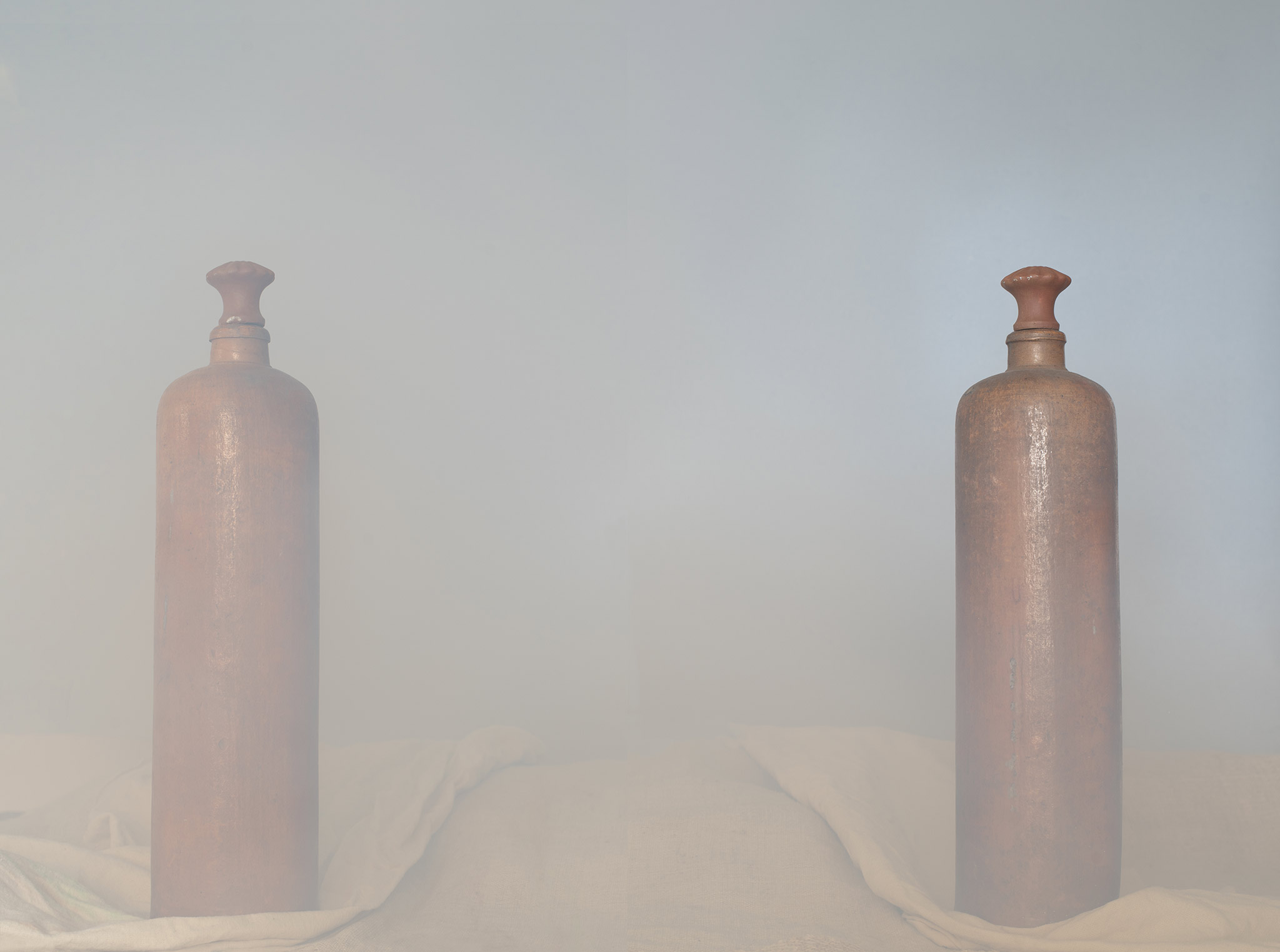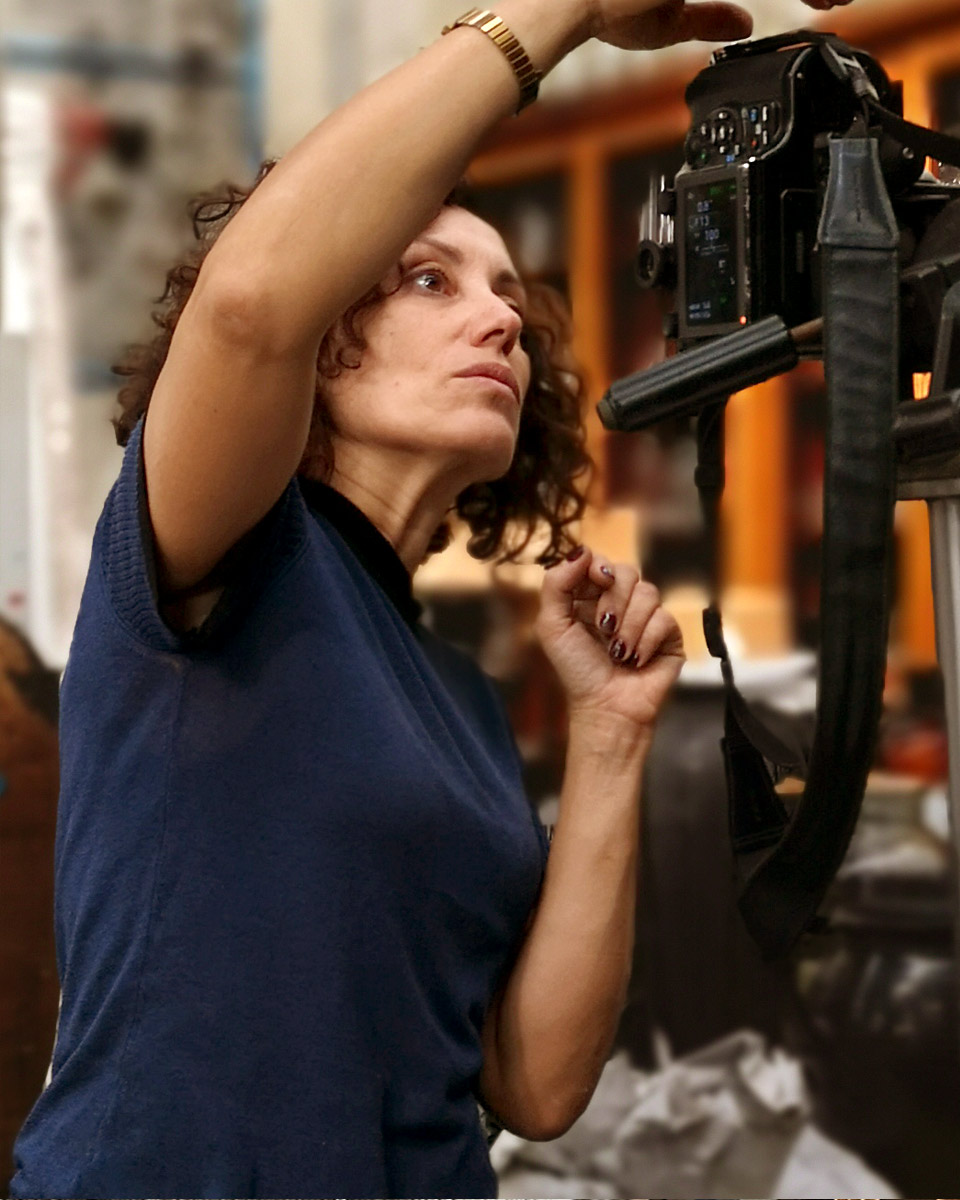
Shifting Focus with Silvia Camporesi

Shifting Focus
The evolution of reality according to Silvia Camporesi
Silvia Camporesi is our 2024 Guest Curator and we could not be happier.
We have been following her work for the past 20 years and chances are, if you are into art photography at all, you have already seen many of her photos.
Through this interview we will try to condense everything you need to know about the work of Silvia Camporesi in our classic short and easy-to-read format, hopefully prompting the desire to search her work online and see more of her many many pictures (her career and achievements are impressive).
We will also tell you about a collaboration project which we are honored to be taking on with Silvia…
Now buckle up, because if you are not a fan of Silvia Camporesi already, we are about to make you one!

La mensa, isola di Pianosa (from the “Atlas Italiae” series, 2015)
October 2023, Silvia Camporesi walks into our showroom on a sunny Italian morning.
She is carrying her gear and a big purple book. It’s not her first time visiting us: she has shot pictures inside our showroom in the past and borrowed objects to use as props in her photos.
Our focus goes straight to the book she’s holding, it’s Mirabilia (!) her latest editorial feat, freshly published, which we are seeing for the first time ever! Mirabilia comes after Atlas Italiae and it also revolves around the theme of “places in Italy”, our country, which is an endless source of inspiration for Camporesi. Mirabilia is a collection of natural and man-made marvels, famous and lesser-known spots, chosen through criteria that are hard to pin-point for me with words, but that appear very clear as an intangible feeling emanating from the pictures that are gathered in this tome:
The common ground is definitely a sense of marvel, if I have to try and put this feeling in words. A sense of absoluteness and that each image is referring to something broader and abstract than what it is showing. Paraphrasing the words of Italian Philosopher Umberto Galimberti: Camporesi’s quest is ultimately beauty and true beauty is always referring to something abstract and intangible. It makes us feel like we can’t quite ever grasp it, thus beauty is ultimately scary!
Silvia Camporesi is Italian, from the Emilia-Romagna region. But it is not her origin, rather her background in philosophy, that you will find cited in almost every interview to her as the fundamental key to understanding her approach to photography.
Camporesi obtained her degree in philosophy at the University of Bologna with a final thesis project on the Austrian philosopher Ludwig Wittgenstein. We’ve read multiple times that the study of philosophy gave her a method that she then transferred to photography, but we wish to dig a little deeper, so please bare with me as we try diving into actual philosophical matters for one short paragraph:
Wittgenstein was not only the subject for Camporesi’s final thesis, but he is also directly cited in the title of an important and much more recent photographic work by Camporesi: Il Mondo è Tutto ciò che Accade (“The world is all that is the case”), 2017 .
We thought it would be important to look him up. To try putting it simply Wittgenstein was a Logical Positivist and believed the scope of philosophy is to investigate objective reality and help mankind find order and universal principles. Progress his ultimate goal.
In his 1921 work Tractatus Logico-Philosophicus this philosopher makes the point that “Everything that happens is a fact and therefore not arguable in its objective reality” and that “Language is the universal code we use to report those facts.” Later in his career W. would actually shift his focus to context and nuance, rethinking his very strict and binary juvenile views.

Parco delle Biancane: Monterotondo Marittimo, Tuscany (from the 2023 “Mirabilia” series)

La casa volante (the Flying house): Castelnuovo Magra, Liguria (from the 2023 “Mirabilia” series)

Marble quarry: Carrara, Tuscany (from the 2023 “Mirabilia” series)

Villa Guastavillani: Bologna, Emilia Romagna (from the 2023 “Mirabilia” series)
G: We look at Mirabilia and find these impalpable connections between different places that we would have probably never thought of looking at side by side. To what degree do you consider to be influenced by the Logical Positivist doctrine. Are you trying “to make order” with your projects? Is there an idea of progress that you are pursuing with your work in a broad sense?
C: I believe we can say all of my works are born out of conceptual research before anything else, and then developed through a method I have perfected over the years. For sure my degree in philosophy has been fundamental in shaping my artistic identity and it is no coincidence that I dedicated one of my first works to Wittgenstein. Mirabilia, as you point out, is a photographic series that gathers in an orderly fashion Italy’s most unusual and bizarre places. Some of them are by nature extremely chaotic. I gave myself the task of obtaining for each location a single and neatly composed picture that could still capture its essence so it could be cataloged and fit within this book. This is indeed a way of assigning an order to otherwise scattered and unrelated bits of reality. It may seem as if there is no link between philosophy and the act of taking pictures, between logic and order, yet over the years I have seen my artistic and photographic research magically develop in constant correlation to my previous studies in philosophy. This is a demonstration that philosophy is so universal that it can be applied to investigate any aspect of life. In regards to my career I wouldn’t say mine is a quest for progress but rather for evolution. It is a path that through losses and falls, rises and rebirths, is pointing towards a specific direction, each day with more clarity.
G: In regards to your artistic pursuit and with Galimberti’s words in mind: is beauty more of a means or of a scope in your work?
C: to me the concept of beauty is in itself intrinsic to photography. However the kind of beauty I’m after is built on imperfection and should not be immediately visible. It is more subtle, it does not shout, sometimes it is disquieting. My goal is to develop complex, highly impactful projects. They must be perfectly coherent both conceptually and esthetically and also very recognizable. My work as a photographer is also a challenge towards the laziness that new technological means have brought to the world of capturing and creating images. The feats I choose for myself are complex and require lots of traveling and planning. Mirabilia and my previous work Atlas Italiae (dedicated to Italy’s abandoned places) are perfect examples.

Picture from the 2000 “Virginia” series
G: From the study of Philosophy you learned the importance of defining good sets of rules and following them strictly. Could you tell us about your first published work that earned you the Guercino prize in the year 2000 and put your name on the global map of Art Photographers? How was it born, how was it received at the time and why is it still relevant today?
C: That work is titled Virginia and is about my grandmother’s home. It was my first time using color film, because up until then I had been shooting only in black and white and would spend countless hours in a darkroom processing film. Virginia was developed over the course of a year during which I paid many visits to my grandmother in her public-housing apartment. My intent was to tell her story through her belongings without ever showing her face. When my images began circulating many people recognized fragments of their own stories, details that projected those personal images into the realm of collectivity. So Virginia became an archetype for “the Italian grandmother”, a representation of people from her time and of a specific lifestyle. Not including her personal identity is what made the pictures so universal. This series obtained many awards, besides the Guercino prize, and to me will always be very important as it marks the beginning of my artistic career.
G: We looked at your most recent, and then at your oldest published work. It is clear that there has been a lot of evolution and with my next questions I will ask you to help us connect these two faraway dots. But first there is a confession I must make to you and to our readers. The opening picture of Mirabilia is a shot of our showroom (this is not the confession yet). I had no idea that picture would be in your book until I first opened it. I was shocked and deeply honored. Yet for some reason I instantly felt a wave of impostor syndrome, as if All’Origine were not up to par with all the other magical places you photographed. Of course I love this place and spend every moment I can inside the showroom, I sure do like it but perhaps it has become too familiar to me to see it as evocative and “hard to grasp” as all the other places you photographed for your book. I mean, beyond the edges of your photo I know exactly what the place looks like. Maybe that’s what is ruining it for me. I honestly don’t know. Now my question doesn’t necessarily require more than a yes or no, but I invite you to elaborate on it as much as you feel necessary: in the early days of your career, before becoming a famed artist, and given your completely different background (at least as far as formal training goes), have you ever had to deal with impostor syndrome? If so, did this inform your work in any way?
C: I like the idea of impostor syndrome! But it actually never happened to me. I would say that on the contrary, having graduated in philosophy in the top of my class, many people would frown upon my decision of pursuing an artistic career as if I were wasting my hard earned degree. But I think each step on a personal journey will eventually make perfect sense in retrospect. Philosophy has given me a method. Photographic techniques were learned over time. Today photography is an instrument I use in all possible ways within the context of my projects, of editorial work, of conferences and talks.

Il Bosco Bianco (from the 2012 series “Qualche volta di Notte”)
G: One of the most famous works from your early career is the 2004 portrait of Ophelia as immortalized by Millais in his famous XIX century painting. You’ve indicated it as one of the high points in your research (obsession?) for water. You have in fact photographed water in many ways and many of its shapes over the years. I’m thinking of Il paese Sommerso (2020), La Terza Venezia (2011) and even Qualche Volta di Notte (2012) where water appears as mist, a very important element in many of your shots. What is it about water that attracts you?
C: Water is basically my natural element. Some of my best ideas came to me while I was swimming. After my earliest experiments capturing objects and people submerged in a river or in my bathtub, I understood the potential of this element. Water is capable of transforming shapes and colors and surrounds everything with a veil of mystery. This is why over the years I have found myself using water in my photos time and time again, and the outcomes never failed to surprise me. The last work you mention, Il Paese Sommerso, was a particularly complex feat: it is dedicated to the abandoned village of Careggine that since the late 1940’s has been resting under 80 meters of freshwater on the bottom of lake Vagli in Tuscany. In the past the lake has been emptied out more than once and the village resurfaced covered in mud, each time in a more advanced state of decay. I surely don’t have the means to take underwater pictures 80 meters below surface, so I gathered archival photos from the last time the lake was emptied in 1994 and had a scale model built by a professional model builder. The model was lowered into a giant aquarium and became the subject of my photos. They were made to look very realistic. This adventure was both complex and very significant to me. In a way it is the conclusion of a long cycle of works dedicated to water.

Ofelia, 2004

Il Paese Sommerso, polyptych (from the series “Forzare il paesaggio”, 2019)
G: I remember from my (sadly rather listless) high school studies that Aristotle maintained that all knowledge is built on previous knowledge, which inspired him to promote the construction of libraries and the preservation of meaningful artifacts. You are known for being an avid reader and cinephile. Your photographic works are sometimes theatrical and faithful reenactments of movie scenes, novels or famous paintings. Yet sometimes the “knowledge you build upon” is extremely processed, to the point it becomes nearly impossible to decode without a verbal explanation of your work. I’m thinking of shots like Les idiots Savants: un Diverso Stato (2004). How do you regard these visual and conceptual bits of shared culture you choose as inspiration for your works?
C: You are referencing my early career, when my approach to photography was very narrative: I would pick literary stories or parts of movies to make into sets that I could capture. Everything was purpose built and my aim was to encapsulate an entire story in a single image. At the time I viewed photography as a means to take a long story and vacuum pack it. This was the intent behind my take on the savant twins from the story “Les Idiots Savants” (from a book by Oliver Sacks) and behind each of the images from the series “Qualche volta di Notte” (dedicated to Antonioni’s movies). These works need to be seen within a context where the story is made explicit, otherwise it is not possible to understand them and these images, even if well composed and esthetically pleasing, will retain no meaning. The reason behind my desire to transform these stories into visual stills comes from my education in philosophy: the process of “conversion” is an analytical way of looking at the world around us.

Les Idiots Savants (from the series “Un diverso stato”, 2004)
The true story referenced in this photo tells of two twins with Savant syndrome observed in the 1960’s by neurologist Oliver Sacks. Despite severe learning disabilities they had extraordinary mnemonic talents. They would play a game in which they took turns listing prime numbers in sequence by memory, up to twenty digits.
G: We are ultimately trying to understand how you look at reality, how your interest towards different facets of reality has evolved and what about reality your works are meant to tell us. There are two very real and very recent events that we both lived through: the 2020 pandemic and the May 2023 flood that interested our region Emilia-Romagna.
The pandemic led you to develop a project called Domestica in which your two young daughters became to some extent co-authors and/or critics of all your shots. Now allow me to go back to Wittgenstein. I read that after his 1921 publication he dedicated himself to a career as a grade school teacher for almost a decade. In 1929 he published more writings in which he credited his pupils, amongst other external factors, as the driving force that made him question his views on the definition of reality. In particular he changed his position on language, which was previously indicated as the universal abstract code mankind uses to describe reality. Seeing the creative and at times unorthodox use of language by young children he shifted his focus to context and ultimately realized that “the same word doesn’t always mean the same thing” to put it once again in an oversimplified manner. I think the question has already written its self. Please tell us about Domestica and how looking at reality together with your daughters made a difference in your work!
C: In the situation we were living during that time Domestica represented an act of survival. I found myself stuck at home with two small children suddenly interrupting my routine of travels and work. I reacted with an artistic act by self-imposing the creation of at least one good image per day. I did so with the collaboration of my daughters. Our whole world had suddenly shrunk to the size of our house. This made each small observable element gain great value: a crack in the backyard wall became an island, a broken dish sparked considerations on the cracks within our lives. The kids offered their fairy-tale vision of the world, childish, extremely creative and sometimes also extremely on-point.

Photo from the series “Domestica”, 2020
G: I mentioned a second very real event. The flood that interested large parts of our region in May 2023.
A very different kind of experience, not shared by the whole of humanity this time… which almost turned you into a news photographer! Or did it not? How did a picture you took of a group of young volunteers land on the cover of Internazionale Magazine?
C: I am lucky to live in a part of Forlì that remained untouched by the flood. As soon as it was possible to go outside I went to see the damage in the rest of my town and took my camera with me. It had a terribly harsh impact on me. The first images I captured were of the local urban park, completely covered in muddy water. For a moment my mind went to my work “La Terza Venezia” in which I used digital manipulation to represent a semi-submerged Venice. When I saw what had happened to my city I couldn’t help but think reality was going way beyond fantasy. After some shots of nature I began photographing houses and only later I started aiming my camera at people. I hadn’t taken pictures of people in years, but at that point I was in the midst of a huge mobilization with people coming from all around Italy to help clean up the mud. These people were an integral part of this devastated urban landscape. I had never tried my hand at news photography before so I proceeded intuitively using the linguistic and esthetic codes I’ve developed in years of art photography. Perhaps this is why the editors at Internazionale noticed my work. After being posted on Instagram my shots were requested by several national newspapers. This series of images was very intense to work on and represents my first time giving a social value to my photographic work.



Sommersi Salvati, 2023
G: The relation between reality and fiction appears beautifully intricate yet spontaneous and innocent in your work. I mean, there is never a bit of deceiving malice and this is something we should treasure in this post-truth era in which most images, purposely created with nefarious intent or not, are constantly being used to push some partisan narrative. Your images are a safe place. They always manage to evocate universal emotions. You say your photos are an attempt to hold on to the idea of reality we have inside our dreams.
Over the past 20 years you have been achieving these results with many tools. By scouting the most remote and off-the-map Italian places, as much as by sourcing objects and props to prepare highly staged photos inside your studio. It is an honor for us to open our ever evolving archive of things to you and to see what you choose to work with to create new images. And this is what you have been doing over the past few months. You have visited All’Origine, prepared sets inside the showroom and also borrowed objects to arrange and shoot inside your studio. These objects served different purposes. In certain shots they represent nothing but themselves, but in others a gin bottle has become the stand-in for a gate pillar, a vase for a soldier, a seltzer bottle for a little girl… We understand your are in the divergent phase of your process: these pictures you shot may be separated into different future projects or may become part of a single work. My final question to you will be a completely open one: please tell us about what you did, what you are doing now and might be doing in the future with this series of photographs!
C: Thank you for summing up so well all these key-elements of my work. Surely I am very prone to experimentation and research, even if I want my work to be always be recognizable. Once again the idea for this project sparked from a book: Figure by Riccardo Falcinelli, a valuable study on the mechanisms that make certain images work better than others. After this read I focused my attention on iconic photos from the XX century and selected a few to be recreated through XX century objects. Being able to choose from your vast assortment enabled me to think only about color, form and proportion, stripping all the meaning from the images I referenced. It comes across as a light and playful series, but these shots actually present a degree of complexity and represent an effort to harness the power of communication through the harmony of shape and color. The hard part is finding the right objects and composing them properly in a custom set; many of my attempts ended up not meeting my expectations, but I am really happy with the images I decided to keep. When this project will have grown big enough I will consider my research complete and it will be ready to go into the world as a publication and in exhibits.

After “The flag of Iwo Jima”, 2022

“Raising the flag on Iwo Jima” Joe Rosenthal, 1945

After “Formigine”, 2022

“Formigine, Ingresso Casa Colonica” Luigi Ghirri, 1988

After “Identical Twins, Roselle, New Jersey”, 2022

“Identical Twins, Roselle, New Jersey” Diane Arbus, 1967

After “Dog legs”, 2023







